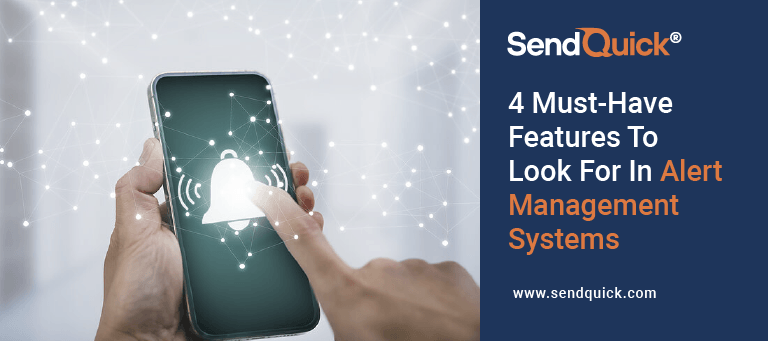Emergencies, such as national weather disasters or cyberattacks, can strike out of the blue and disrupt business operations without notice. This unpredictability is why having both a business continuity plan and an advanced emergency alert system is critical to an organisation’s survival. A relevant example is the recent pandemic, wherein 34% of employers had no emergency preparedness plan before government entities enforced the lockdown restrictions.
Suffice to say, those trying to recover with no emergency management plan to follow are facing an uphill battle given the cost involved in business recovery. Hence, it is common for some companies to fail in just the first year after a major incident. Modern emergency alert systems now go beyond just organisation-wide employee notifications; it also ensures the well-being of employees, improves interdepartmental communications, and minimises the company’s economic loss. Below, we go over four essential features every top-notch emergency alert system software should have.
1. Multi-channel and two-way communication
Proper communication is only possible if it is a two-way process. During emergencies, a two-way bi-directional response system facilitates the notification process, keeps organisations in touch with their crisis teams, and offers life-saving advantages.
Two-way messaging or bi-directional communication lets employees not just receive timely alerts but also respond to them. For instance, companies can request employees reply with a set prompt to confirm receipt of the message, a feature that greatly helps risk management teams measure the alert system’s performance.
Bi-directional communication systems allow for sending push notifications, email, text, and voice messages from various devices and receive quick responses to confirm those who are okay and who are not to prioritise resources accordingly. The capability of sending SMS texts, emails, voice messages, and push or desktop notifications simultaneously to reach different teams increases the likelihood of them receiving alerts on time. These message and report templates should also be easily customised based on their content and the recipient’s department or group, location, role, and more.
For emergency notification and incident management, using a mobile-first strategy is highly recommended as virtually everyone now has smartphone communication access. This allows for quick response in employees and lets companies protect their workforce wherever they may be.
In conjunction with two-way communication, emergency alerts should also be available through many different channels, such as:
- SMS
- Voice messages by phone (and voicemail)
- Push notifications
- Computer desktop notifications
- Online messaging platforms
- Other communication mediums used by the organisation
Leveraging all available communication routes and, ideally, setting a preference priority for each employee virtually guarantees that messages will be read and improves response times. Bi-directional mass messaging can go further beyond by incorporating up-to-the-minute updates. A call-in announcement feature is also handy for letting employees seeking emergency updates contact the company directly.
2. Rapid response via geofencing and quick templates
Although emergency alert systems are the cornerstone of risk management, rapid response is also essential. When disaster strikes, every second matters. Notifying supervisors and managers is not enough. Thus, to make sure organisation leaders and employees respond quickly regardless of their department or location, an emergency alert system must feature built-in tools for customisation, like device delivery and geo-targeting.
Risk management teams can modify alerts for each role and department to streamline procedures such as evacuations, IT system backups, data backup and recovery, electrical safety, general operational safety procedures, and many other emergency protocols.
3. Integration and communication
All-in-one IMP platforms integrate business continuity planning, emergency preparation, and rapid incident and emergency response in one powerful tool, helping companies save time and money on business recovery.
An integrated emergency alert system is a critical tool for organisations that expand their operations nationwide or globally. This is because engaging the entire organisation and getting them on board with all the business continuity processes can prove challenging.
For these large-scale businesses, a versatile incident management solution is necessary for responding to and resolving incidents at any branch office, whether in a local or foreign location. As more companies adopt the remote working model, versatile solutions will become more important for adapting to shifting work environments, geo-locations, and evolving employee behaviours.
4. Streamline incident management processes and reporting
The main objective of incident management is to resolve incidents quickly and efficiently to mitigate as much operational loss as possible. A business continuity solution without accessing it anywhere, anytime, is also at risk of revenue loss and data loss.
Every incident management plan must have an emergency alert solution for disasters of all severities, from local to national. Business continuity planning software comes with incident management tools that allow organisations to detect, monitor, analyse, and mitigate future losses from forecasted disasters.
Conclusion
Regardless of the context, being unprepared comes at a high cost. As such, drafting a comprehensive business continuity plan and pairing it with a robust emergency alert system is essential to overcoming any future incident or disaster.
Check out SendQuick’s comprehensive IT alert notification platform. Our alert management system comes with all the capabilities mentioned above and the “Escalation” feature. It escalates alert messages to the superior of a given recipient should they fail to reply after a set amount of time and bring up the matter to the former’s attention.
More than just a traditional SMS gateway provider, SendQuick is a leading enterprise mobility solutions provider headquartered in Singapore. To learn more about our notification management solutions and other products, such as our email to SMS gateway, visit our solutions page today or contact us to speak with a SendQuick expert for more details.






